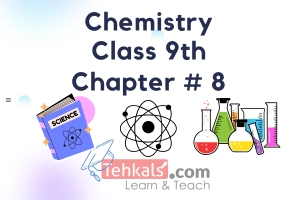Chemistry Class 9 Chapter 7
Published: 4 Nov 2023
Chemistry Class 9 Chapter 7 is about “Electrochemistry”. This article includes the MCQs of Chemistry class 9th chapter 7.
Chemistry Class 9 Chapter 7 Notes
Electrochemistry Notes
Chemistry Class 9 Chapter 7 MCQs
1. In electrochemistry, we study about _______ changes.(a) Physical
(b) Chemical
(c) Analytical
(d) Industrial
Show Answer
Chemical
2. Electrochemistry is the interconversion of electrical energy and ________energy.
(a) Chemical
(b) Potential
(c) Kinetic
(d) Physical
Show Answer
Chemical
3. Electrons are lost in oxidation and gained in reduction, therefore, when oxidation occur in a chemical reaction, reduction must occur__________.
(a) separately
(b) Simultaneously
(c) Formally
(d) All of these
Show Answer
Simultaneously
4. The addition of _____to substance is called oxidation.
(a) Carbon
(b) Hydrogen
(c) Oxygen
(d) Helium
Show Answer
Oxygen
5. $ C + O_2 \quad \longrightarrow ? $
(a) $ CO_2 $
(b) $ CO + O_2 $
(c) $ CO_3 $
(d) $ None \ of \ these $
Show Answer
$ CO_2 $
To Download Complete Notes of Chemistry Notes 9 Class, Click on the given link.
6. The _________ of hydrogen or other electropositive elements from a substance is called oxidation.(a) Addition
(b) Removal
(c) change
(d) All of these
Show Answer
Removal
7. $ 2NH_3 + 3Cl_2 \quad \longrightarrow ? $
(a) $ N_2+3H_2+3Cl_2 $
(b) $ 2NH_2+4HCl $
(c) $ N_2¬+6HCl $
(d) $ H_2+ SO_4 $
Show Answer
$ N_2+6HCl $
8. The removal of ___________from a substance is called oxidation.
(a) Electrons
(b) Proton
(c) Neutrons
(d) None of these
Show Answer
Electrons
9. $ Fe^{+2} \quad \longrightarrow Fe^{+3} + e^- . $ What process has occurred?
(a) Aeration
(b) Oxidation
(c) Reduction
(d) Induction
Show Answer
Oxidation
10. The removal of __________from a substance is called reduction.
(a) Carbon
(b) Hydrogen
(c) Oxygen
(d) Nitrogen
Show Answer
Oxygen
11. $ 2HgO \quad \longrightarrow 2Hg + O_2 $ is due to
(a) Catalyst
(b) Heating
(c) Reagent
(d) Melting
Show Answer
Heating
12. The addition of ___________to a substance is called reduction.
(a) Hydrogen
(b) Sulpher
(c) Oxygen
(d) Nitrogen
Show Answer
Hydrogen
13. $ N_2 + 3H_2 \quad \longrightarrow ? $
(a) $ NH_4 + NH_2 $
(b) $ 2NH_2 + H_2 $
(c) $ 2NH_3 $
(d) $ None \ of \ these $
Show Answer
$ 2NH_3 $
14. The _________ of electrons to a substance is called reduction.
(a) Protons
(b) electrons
(c) Neutrons
(d) All of these
Show Answer
electrons
15. $ Sn^{+4} + 2e^- \quad \longrightarrow Sn^{+2}. $ What has happened in this chemical reaction?
(a) Gain of election
(b) Loss of electrons
(c) Loss of protons
(d) None of these
Show Answer
Gain of election
16. Those reaction in which gain and loss of electrons takes place simultaneously is called _____ reaction.
(a) Displacement
(b) redox
(c) Cathodic
(d) None of these
Show Answer
redox
17. _________ $ \quad \longrightarrow 2NaCl $
(a) $ Na + Cl $
(b) $ 2Na + Cl $
(c) $ 2Na + Cl_2 $
(d) $ 5Na + Cl_3 $
Show Answer
$ 2Na + Cl_2 $
18. The apparent charge, positive or negative, on an atom of an element in a molecular or ion is called _________.
(a) Oxidation number
(b) Oxidation state
(c) Both a and b
(d) None of these
Show Answer
Both a and b
19. Unlike ionic charges, oxidation number do not have an exact ________meaning.
(a) physical
(b) Organic
(c) Biological
(d) Chemical
Show Answer
physical
20. The _________ of solution changes with change of oxidation state.
(a) Structure
(b) colour
(c) Elegance
(d) None of these
Show Answer
colour
21. The oxidation number of all elements in free state is:
(a) Zero
(b) Positive
(c) Negative
(d) Neutral
Show Answer
Zero
22. Which of the following has zero oxidation state?
(a) $ H_2 $
(b) $ Cl_2 $
(c) $ Na $
(d) $ All \ of \ these $
Show Answer
All of these
23. The oxidation number of __________is the same as the charge on it
(a) Simple ion
(b) Molecular ion
(c) Molecule
(d) Molecular force
Show Answer
Simple ion
24. The oxidation number of hydrogen in its compound is:
(a) $ +5 $
(b) $ +1 $
(c) $ +7 $
(d) $ +3 $
Show Answer
$ +1 $
25. In the exceptional case of metal hydrides, hydrogen has _____________oxidation state.
(a) $ -5 $
(b) $ -1 $
(c) $ -7 $
(d) $ -3 $
Show Answer
$ -1 $
26. The oxidation number of oxygen in its compound is:
(a) $ -2 $
(b) $ -3 $
(c) $ -4 $
(d) $ -5 $
Show Answer
$ -2 $
27. In case of peroxide, oxygen has _____________ oxidation state.
(a) $ -4 $
(b) $ -3 $
(c) $ -2 $
(d) $ -1 $
Show Answer
$ -1 $
28. The oxidation number of each element of group 1 is.
(a) $ +1 $
(b) $ +2 $
(c) $ +3 $
(d) $ +4 $
Show Answer
$ +1 $
29. The oxidation state of each element of group 2 is.
(a) $ +1 $
(b) $ +2 $
(c) $ +3 $
(d) $ +4 $
Show Answer
$ +2 $
30. The oxidation state of each element of group 3 is :
(a) $ +1 $
(b) $ +2 $
(c) $ +3 $
(d) $ +4 $
Show Answer
$ +1 $
31. The oxidation number of each element of halogens in their binary compound is ______________.
(a) $ +1 $
(b) $ -1 $
(c) $ +3 $
(d) $ -3 $
Show Answer
$ -1 $
32. In neutral molecules, the algebraic sum of the oxidation number of all the elements is _______________.
(a) Zero
(b) Five
(c) Seven
(d) Nine
Show Answer
Zero
33. In any substance, the more __________ action has the negative oxidation number.
(a) Electropositive
(b) Neutral
(c) electronegative
(d) None of these
Show Answer
electronegative
34. An oxidizing agent is a specie that ____________a substance and itself get reduce.
(a) oxidizes
(b) Neutralize
(c) Reduce
(d) None of these
Show Answer
oxidizes
35. What is the example of oxidizing agent?
(a) $ KMnO_4 $
(b) $ H_2S $
(c) $ Na $
(d) $ Al $
Show Answer
$ KMnO_4 $
36. An oxidizing agent may be the ________ of oxygen to a substance.
(a) Acceptor
(b) Share
(c) donor
(d) None of these
Show Answer
donor
37. An oxidizing agent may be the __________of a hydrogen from a substance.
(a) Acceptor
(b) Share
(c) Donor
(d) None of these
Show Answer
Acceptor
38. An oxidizing agent may be the acceptor of _____from a substance.
(a) Proton
(b) electron
(c) Neutron
(d) None of these
Show Answer
electron
39. The oxidation number of an oxidizing agent is ________during a redox reaction.
(a) decreased
(b) Constant
(c) Increased
(d) None of these
Show Answer
decreased
40 A specie that reduces a substance and itself gets oxidized is called ____________agent.
(a) Oxidizing
(b) Reducing
(c) Reducing sugars
(d) All of these
Show Answer
Reducing
41. Which of the following is a reducing agent?
(a) $ K_2Cr_2O_7 $
(b) $ HNO_3 $
(c) $ SO_2 $
(d) $ Cl_2 $
Show Answer
$ SO_2 $
42. A reducing agent may be the acceptor of ________from a substance.
(a) oxygen
(b) Hydrogen
(c) Carbon
(d) Helium
Show Answer
oxygen
43. A reducing agent may be the ______________of hydrogen to a substance.
(a) Acceptor
(b) Share
(c) Donor
(d) None of these
Show Answer
Donor
44. A reducing agent may be the donor of an ______to a substance.
(a) Proton
(b) Electron
(c) Neutron
(d) All of these
Show Answer
Electron
45. The oxidation state of a reducing agent is ________during a redox reaction.
(a) Increased
(b) Constant
(c) Decreased
(d) None of these
Show Answer
Increased
46. $ Cu^{+2} + Zn^o \quad \longrightarrow Zn^{+2} + Cu^? $ What will be the oxidation state of copper in products?
(a) $ 0 $
(b) $ +1 $
(c) $ -1 $
(d) $ +2 $
Show Answer
$ 0 $
47. A device in which inter conversion of electrical and chemical energies takes place is called __________.
(a) Battery
(b) Electrode
(c) Electrochemical Cell
(d) None of these
Show Answer
Electrochemical Cell
48. An _________ is a substance in solution or in molten state, which ionizes into positive and negative ions and conducts electricity.
(a) Electrolyte
(b) Battery
(c) Isomer
(d) None of these
Show Answer
Electrolyte
49. Which of the following is the example of electrolyte?
(a) $ NaCl $
(b) $ HCl $
(c) $ NaOH $
(d) $ All \ of \ them $
Show Answer
All of them
50. Those substances which ionize completely in aqueous solution or in molten state and conduct electric current to a larger extent is called _____________.
(a) Weak electrolyte
(b) Strong electrolyte
(c) Non-electrolyte
(d) None of these
Show Answer
Strong electrolyte
51. Which of the following is the example of strong electrolyte?
(a) $ H_2SO_4 $
(b) $ NH_4OH $
(c) $ C_6H_6 $
(d) $ None \ of \ these $
Show Answer
$ H_2SO_4 $
52. Those substances which ionizes partially in aqueous solution or in molten state and conduct electricity to a very small extent is called_____________.
(a) Strong electrolyte
(b) Weak electrolyte
(c) Non-electrolyte
(d) None of these
Show Answer
Weak electrolyte
53. Which of the following is the example of weak electrolyte?
(a) $ Urea $
(b) $ NaCl $
(c) $ CH_3COOH $
(d) $ None \ of \ these $
Show Answer
$ CH_3COOH $
54. $ CH_3COOH_{(aq)} \quad \longrightarrow ? $
(a) $ CH_3COO^-_{(aq)} + H^+_{(aq)} $
(b) $ C_2O_2^- + 2 H_2^+ $
(c) $ CH_4CO^- + O^+ $
(d) $ None \ of \ these $
Show Answer
$ CH_3COO^-_(aq) + H^+_(aq) $
55. Those substances which do not dissociate in aqueous solution or in molten state, therefore donot conduct electricity is called_________________.
(a) Strong electrolyte
(b) Weak electrolyte
(c) Non-electrolyte
(d) All of these
Show Answer
Non-electrolyte
56. Which of the following is the example of non-electrolyte?
(a) Sugar
(b) Urea
(c) Glucose
(d) All of these
Show Answer
All of these
57. __________are the conductors i.e. metallic plates, wires or rods, through which electrons enters or leaves the electrolytes in a cell.
(a) Electrodes
(b) Allotropes
(c) Alloys
(d) None of these
Show Answer
Electrodes
58. How many types of electrodes are there?
(a) 1
(b) 2
(c) 3
(d) 4
Show Answer
2
59. The ____________is the positive electrode at which the anion gather and leaves the electron in the electrolytic cell.
(a) Anode
(b) Electrode
(c) Cathode
(d) None of these
Show Answer
Anode
60 What type of charge is there on anions?
(a) Positive
(b) Neutral
(c) Negative
(d) None of these
Show Answer
Negative
61 The __________ is the negative electrode at which cation gathers and gains the electrons in the electrolytic cell.
(a) Anode
(b) Cathode
(c) Electrode
(d) None of these
Show Answer
Cathode
62. What type of charge is there on cations?
(a) Positive
(b) Neutral
(c) Negative
(d) None of these
Show Answer
Positive
63. When electrical energy is required to produce a redox reaction and bring a chemical change in an electrochemical cell is called ____________cell.
(a) Voltaic
(b) Electrolytic
(c) Daniel
(d) None of these
Show Answer
Electrolytic
64. The example of electrolytic cell is ________________.
(a) Down cell
(b) Nelson cell
(c) Daniel cell
(d) Both a and b
Show Answer
Both a and b
65. The process of chemical breakdown of an electrolyte in molten or solution form by passing current is called________.
(a) Electrolysis
(b) Catalysis
(c) Chemolysis
(d) analysis
Show Answer
Electrolysis
66. The electrodes are connected to the terminals of the ___________.
(a) Cell
(b) battery
(c) Both a and b
(d) None the these
Show Answer
battery
67. Pure copper is a good __________of electricity and is used in electrical instruments.
(a) Conductor
(b) Insulator
(c) Non-electrolyte
(d) None of these
Show Answer
Conductor
68. Cupper is purified by _________________.
(a) Destructive distillation
(b) electro-refining
(c) Metallurgy
(d) None of these
Show Answer
electro-refining
69. In electro-refining, cupper is purified by applying _______ temperature and applied voltage of about $ 0.3 \ volts $.
(a) $ 50^oC $
(b) $ 25^oC $
(c) $ 100^oC $
(d) $ 75^oC $
Show Answer
$ 50^oC $
70. In electro-refining of copper, which reaction occurs at anode?
(a) Reduction
(b) Oxidation
(c) Both (a) and (b)
(d) None of these
Show Answer
Oxidation
71. In electro-refining of copper, reduction occurs at ____________.
(a) cathode
(b) Anode
(c) Both and b
(d) None of these
Show Answer
cathode
72. By electrolytic refining, upto _____________pure copper is obtained.
(a) 90.3 %
(b) 93.5 %
(c) 95.9 %
(d) 99.9 %
Show Answer
99.9 %
73. The device in which chemical energy is converted into electrical energy is called ___________cell.
(a) Electrolytic
(b) Voltaic
(c) Galvanic
(d) Both a and b
Show Answer
Both a and b
74. In voltaic cell, which type of reaction occurs?
(a) spontaneous
(b) Non-spontaneous
(c) Both (a) and (b)
(d) None of these
Show Answer
spontaneous
75. The example of voltaic cell is _____________cell.
(a) Down
(b) Daniel
(c) Nelson
(d) All of these
Show Answer
Daniel
76. A galvanic cell consists of two separate containers, each container is called a _____________.
(a) Half cell
(b) Binary cell
(c) Electrode
(d) None of these
Show Answer
Half cell
77. In each half cell, an electrode is dipped in $ 1M $ solution of its own____________.
(a) Acid
(b) Base
(c) Salt
(d) All of them
Show Answer
Salt
78. The two solutions in different containers are connected with bridge called ___________.
(a) Salt bridge
(b) Smudge
(c) Sludge
(d) Clutch
Show Answer
Salt bridge
79. The salt bridge is a _____________tube.
(a) C-shaped
(b) O-shaped
(c) U-shaped
(d) L-shaped
Show Answer
U-shaped
80. The U-Shaped tube in voltaic cell is filled with ________________.
(a) Electrolyte gel
(b) Suspension
(c) Allotropes
(d) None of these
Show Answer
Electrolyte gel
81. The example of electrolytic gel present in the bridge of voltaic cell is _________________.
(a) $ NaCl $
(b) $ K_2SO_4 $
(c) $ H_2SO_4 $
(d) $ Cl^- $
Show Answer
$ K_2SO_4 $
82. The net chemical changes obtained by adding the __________half cell reactions are called cell reaction.
(a) 02
(b) 04
(c) 06
(d) 08
Show Answer
02
83. A Galvanic cell converts chemical energy into _________energy.
(a) Biological
(b) Kinetic
(c) Potential
(d) electrical
Show Answer
electrical
84. An electrolytic cell converts electrical energy into _________energy.
(a) Kinetic
(b) Chemical
(c) Potential
(d) Heat
Show Answer
Chemical
85. In Galvanic cell, the redox reaction is _____________.
(a) Spontaneous
(b) Constant
(c) Non-spontaneous
(d) None of these
Show Answer
Spontaneous
86. In electrolytic cell, the redox reaction is _______________.
(a) spontaneous
(b) Constant
(c) Non-spontaneous
(d) None of these
Show Answer
Non-spontaneous
87. A group of _______cells joined in series is called battery.
(a) Electrolytic
(b) galvanic
(c) Nelson
(d) None of these
Show Answer
galvanic
88. Car batteries consist of __________or more identical voltaic cells connected in series.
(a) 6
(b) 9
(c) 12
(d) 15
Show Answer
6
89. A battery converts chemical energy into __________energy.
(a) Potential
(b) Kinetic
(c) Electrical
(d) Chemical
Show Answer
Electrical
90. The dry cell was prepared by LECLANCHE in ________________.
(a) 1787
(b) 1887
(c) 1987
(d) 1947
Show Answer
1887
91. The electrochemical cell or batteries are used in _____________.
(a) Flashlights
(b) Calculators
(c) Automobiles
(d) All of them
Show Answer
All of them
92. Sodium was first discovered by an English chemist ____________in 1807.
(a) Humphrey Davey
(b) Leclanche
(c) Gregory
(d) None of these
Show Answer
Humphrey Davey
93. The melting point of sodium chloride is ____________.
(a) $ 801^oC $
(b) $ 1000^oC $
(c) $ 1890^oC $
(d) $ 1313^oC $
Show Answer
$ 801^oC $
94. Which of the following is the most abundant metal on earth’s crust?
(a) Zinc
(b) Gold
(c) Mercury
(d) Aluminum
Show Answer
Aluminum
95. A concentrated aqueous solution of sodium chloride (NaCl) is called_________.
(a) Asbestos
(b) brine
(c) Catalyst
(d) Dry cell
Show Answer
brine
96. A slow and continuous eating away of a metal by the environment is called____________.
(a) Rust
(b) corrosion
(c) Radical
(d) Isotope
Show Answer
corrosion
97. Corrosion is a naturally occurring spontaneous phenomena and it drives materials to its _______possible energy states.
(a) Lowest
(b) Intermediate
(c) Highest
(d) None of these
Show Answer
Lowest
98. Corrosion is oxidation-reduction process which takes place by the action of _________in presence of moisture with the metals.
(a) $ NH_3 $
(b) Air
(c) Sulpher
(d) hydrogem
Show Answer
Air
99. The most common example of corrosion is rusting of :
(a) Gold
(b) Silver
(c) iron
(d) Platinium
Show Answer
iron
100. The corrosion of iron is commonly known as___________.
(a) Rusting
(b) Corrosion
(c) Detoxification
(d) Purification
Show Answer
Rusting
101. The necessary conditions for rusting is __________.
(a) Moisture
(b) Air
(c) $ CO_2 $
(d) Both (a) and (b)
Show Answer
Both (a) and (b)
102. Iron rusts by combining with oxygen in the presence of :
(a) Chloroform
(b) Water
(c) Benzene
(d) Ester
Show Answer
Water
103. When iron rusts, it forms brown hydrated mass called ______________.
(a) Ferric oxide
(b) Ferrous oxide
(c) Ferrum oxide
(d) None of these
Show Answer
Ferric oxide
104. Dents and stains are the site for the process of ______________.
(a) Evaporation
(b) Condensation
(c) rusting
(d) None of these
Show Answer
rusting
105. At anode, $ 2Fe_{(s)} \quad \longrightarrow 2Fe^{+2}_{(aq)} + $ _______________.
(a) $ 2es^- $
(b) $ 4es^- $
(c) $ 6es^- $
(d) $ 8es^- $
Show Answer
$ 4es^- $
106. The loss of electron _________the metal.
(a) damage
(b) Stable
(c) Repair
(d) None of these
Show Answer
damage
107. The rust mass is _______ and porous in nature and therefore cannot prevent further atmospheric action.
(a) Hard
(b) Allergic
(c) Soft
(d) None of these
Show Answer
Soft
108. Paints and coatings are used to _________metal from corrosion effects.
(a) protect
(b) Damage
(c) Corrode
(d) None of these
Show Answer
protect
109. The modern paints contain a combination of chemicals called____________.
(a) Suspension
(b) Isomers
(c) stabilizers
(d) None of these
Show Answer
stabilizers
110. An __________is a homogenous mixture of metals or a mixture of metals and non-metals.
(a) Isotope
(b) Alloy
(c) Polonium
Show Answer
Alloy
(d) None of these111. Alloying also helps to ________corrosion of metals.
(a) Protect
(b) Damage
(c) Corrode
(d) All of these
Show Answer
Protect
112. The best example of alloy is a __________which is a solid mixture of iron, chromium and nickel.
(a) PVC
(b) Acetylene
(c) Stainless steal
(d) None of these
Show Answer
Stainless steal
113. A thin coating of one metal on another can applied by ___________.
(a) Spraying
(b) Galvanizing
(c) Electroplating
(d) All of them
Show Answer
All of them
114. ___________protection is used to protect iron in buried fuel tanks and pipelines.
(a) Alloying
(b) Cathodic
(c) Paints
(d) Plating
Show Answer
Cathodic
115. When metal ion is reduced by passing electricity and a solid metal is deposited on a surface is called ______.
(a) electroplating
(b) Galvanizing
(c) Half Cell
(d) None of these
Show Answer
electroplating
116. The __________is an aqueous solution of a salt of the respective metal which is to be deposited on the metal.
(a) electrolyte
(b) Bas
(c) Acid
(d) None of these
Show Answer
electrolyte
117. An electroplating is used to weld the broken parts of the machinery by depositing the ______on it.
(a) Non-metal
(b) Gas
(c) Metal
(d) None of these
Show Answer
Metal
118. An electroplating is used for _____purposes.
(a) Corrosion
(b) decoration
(c) Ionization potential
(d) None of these
Show Answer
decoration
119. To deposit the noble metals like ___________and silver on an inferior metal to enhance its beauty.
(a) Gold
(b) Lithium
(c) Rhodium
(d) None of these
Show Answer
Gold
120. The oxidation number nitrogen $ N_2 $ is
(a) $ +1 $
(b) $ +3 $
(c) $ 0 $
(d) $ -3 $
Show Answer
$ 0 $
121. What is the oxidation number $ C \ in \ CH_3OH: $
(a) $ -2 $
(b) $ -1 $
(c) $ 0 $
(d) $ +1 $
Show Answer
$ -2 $
122. A cation is:
(a) Neutral
(b) Negatively charged
(c) Positively charged
(d) No charges
Show Answer
Positively charged
123. Electrons are lost by the :
(a) Reducing agent as it undergoes oxidation
(b) Reducing agent as it undergoes reduction
(c) Oxidizing agent as it undergoes oxidation
(d) Oxidizing agent as it undergoes reduction
Show Answer
Reducing agent as it undergoes oxidation
124. What is the oxidation number assigned to manganese in KMnO¬4:
(a) +7
(b) +3
(c) +2
(d) +4
Show Answer
+7
125. In a particular redox reaction, the oxidation number of phosphorus changed from -3 to 0. From this information, it may be concluded that phosphorus:
(a) Last 3 electrons and was reduced
(b) Last 3 electrons and was oxidized
(c) Gained 3 electrons and was reduced.
(d) Gained 3 electrons and was oxidized.
Show Answer
Last 3 electrons and was reduced
126. Which statement is true for an electrochemical cell;
(a) Oxidation occurs at the anode only
(b) Reduction occurs at the anode only
(c) Oxidation occurs at both the anode and cathode
(d) Reduction occurs at both the anode and cathode.
Show Answer
Oxidation occurs at the anode only
127. In which of the following does Sulpher have an oxidation number of +7:
(a) HSO-3
(b) SO3
(c) H2SO4
(d) H¬2S2O8128. What happens to the reducing agent in an oxidation-reduction reaction:
(a) It is oxidized as it gains electrons
(b) It is oxidized as it loses electrons
(c) It is reduced as it gains electrons
(d) It is reduced as it loses electrons.
Show Answer
It is oxidized as it loses electrons
129. In an electrochemical cell, electrons travel in which direction
(a) From the anode to the cathode through the external circuit
(b) From the anode to the cathode through the salt bridge.
(c) From the cathode to the anode through the external circuit
(d) From the cathode to the anode through the salt bridge
Show Answer
From the anode to the cathode through the external circuit






Tehkals.com provide us a better explanation about our topics. It help us to revise our homeworks